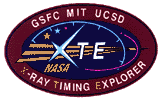DEFAULT Lower Energy Bound = 10 keV (was 12 keV)DEFAULT Lower
Energy Bound on their target form, the HEXTE Lower Level Discriminators
(LLDs) will now be set to admit photons with energies of 10 keV or above.
Compared to the previous default value of 12 keV, total HEXTE source count rates will be increased by the extra 2 keV (= 2 PHA channels) of low energy response (e.g. by 30% for a Crab-like source spectrum), which will also increase telemetry rates in Event List modes. The total background count rate is increased by a negligible amount.
Note that the HEXTE's advertised energy range is 15-250 keV, in order to
maintain a useful overlap with the PCA. The DEFAULT lower
energy bound was lowered from 12 keV to reduce any residual effects of the
LLD cutoff profile on the HEXTE's effective area over the 15-20 keV range.
Timing observations may also benefit from the increased source count rates.
Users should note, however, that an accurate spectral calibration of the
HEXTE below 15 keV is problematic, so they should still exercise caution
when using data below PHA channel 15 in spectral fits.
DEFAULT on-source dwell cycle = 32 s (was 16
s)DEFAULT Dwell Time
on their target form, the HEXTE's source/background sampling interval
will now be set to 32 s.
The original DEFAULT on-source dwell cycle of 16 s provided the
HEXTE's fastest source/background sampling interval. This affords the most
accurate background subtraction but is the least efficient, since 4 s of
data is lost from each background dwell due to the clusters' motion.
In order to prolong the useful life of the rocking mechanism, and to
increase off-source observing efficiency, the HEXTE team have changed the
DEFAULT dwell time to 32 s for Cycle 3 observations. Some
timing observations will also benefit from the reduced power in harmonics of
the rocking period.
An analysis of existing data from Cycles 1 and 2 indicate that the longer source/background sampling interval will have negligible effect on the accuracy of HEXTE background subtraction. However, the HEXTE team will continue to evaluate background subtraction accuracy with 32 s sampling during Cycle 3.


High Energy X-ray Timing Experiment